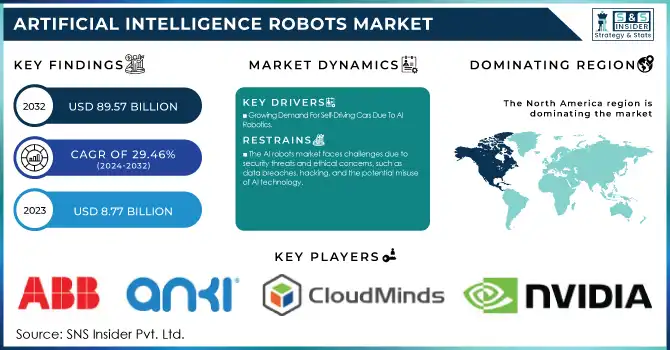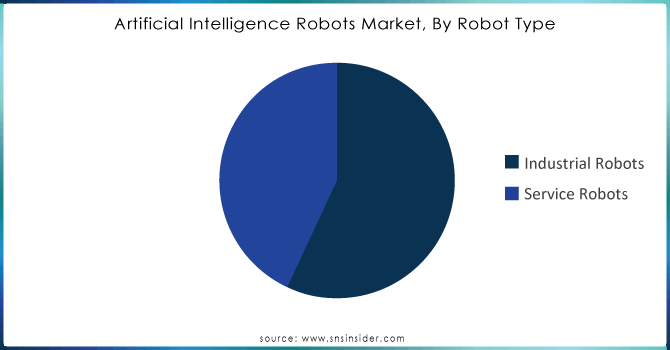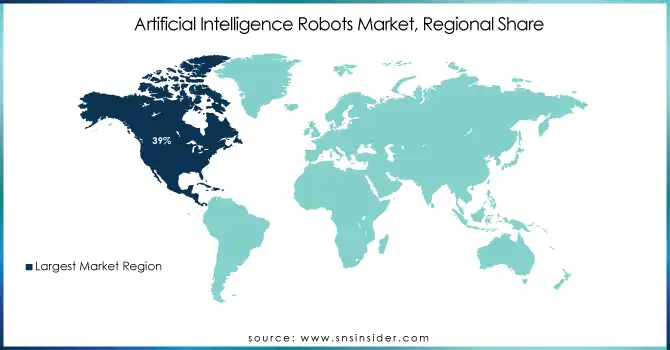Artificial Intelligence Robots Market Size & Trends:
The Artificial Intelligence Robots Market Size was valued at USD 8.77 Billion in 2023 and is expected to reach USD 89.57 Billion by 2032 and grow at a CAGR of 29.46% over the forecast period 2024-2032.

Get more information on Artificial Intelligence Robots Market - Request Sample Report
The increasing integration of AI robots across different sectors is a key factor propelling the growth of the AI robots market, as organizations are looking to improve performance, productivity and operational efficiency. As 57% of employers look to automation and robotics to increase productivity, AIbots provide the bonus of lowering equipment and machinery maintenance costs by 30% and avoiding 70% of breakdowns through predictive maintenance.
Apart from improving efficiency, these robots are creating new job positions as well, countering the stereotype that automation results in job losses. Rather, the growing use of AI on the job is likely to allow companies to employ more workers for changing jobs. AI robots have great value in highly repetitive, hazardous or time-consuming tasks and enable employees to concentrate on more complex, added value activity. The advent of Industry 4.0, an ecosystem of AI, big data, and IoT that is driving this transformation, is making robots more flexible and intelligent in intricate environments. Demand for automation is booming as sectors such as manufacturing, logistics and agriculture adopt AI robots at breakneck speed in a global push towards operational efficiency. In conclusion, this trend will lead to a more sophisticated, technology-powered workforce that will serve both automated systems and human-centered roles.
Artificial Intelligence Robots Market Dynamics
Drivers
-
Growing Demand For Self-Driving Cars Due To AI Robotics
AI robotics is one technology that is increasingly driven by the demand for vehicles to drive themselves, such as self-driving cars, UAVs, and drone aircraft. Role of AI Robotics in navigation, making decisions, and processing real-time data. Prominent among them are firms such as Nvidia, which are facilitating rapid moves into the automotive sector to business autonomous vehicles by offering various AI technology. AI-based systems now more than ever enable the ability to navigate through complex environments, detect obstacles and make real-time decisions. From there, these tech developments have moved beyond automotive into industries such as logistics, agriculture, and deliveries, creating a frenzy of demand. Automating driving systems to make vehicles operate within honest, gross mechanics safe, correct, and smart, is the part that AI robotics play in this transition. As automation technology reshapes industries, the increasing sophistication of autonomous vehicles will no longer be limited to autonomous driving functions, but will encourage a worldwide transformation of smarter and more efficient transport systems.
Restraints
-
The AI robots market faces challenges due to security threats and ethical concerns, such as data breaches, hacking, and the potential misuse of AI technology.
This specific vulnerability makes defense and healthcare one of the most high-risk industries when it comes to the repercussions of a breach. Due to their nature, these sectors are regular targets of exploitation by malicious actors, which would necessitate extremely robust cybersecurity for any AI robots deployed in them. With the ever-changing nature of AI and its growing presence and influence over critical infrastructure, it becomes more necessary to ethically secure the potential challenges it may bring. The ethical implications of AI governance and privacy, as well as misuse of the technology, take on a different tone when robots are not just theoretical constructs, but humanoids that people can perceive and feel. Additionally, keeping these technologies secure from outside forces while ensuring the privacy of the individuals and businesses who will use them is an unfolding concern. This task of continuously innovating while implementing a pro-security strategy is crucial as it goes a long way in both safeguarding the technology along with the industries that rely on them.
AI Robots Market Segmentation Analysis
By Offering
In 2023, the hardware segment of the artificial intelligence Robots market serves as the primary driver, capturing a majority share of about 59% of the market. The growth of the enterprise-computing sector and demand for processors, graphics cards, and other components used in AI workloads contribute to this dominance. AI is not simply a software-driven endeavor; robust hardware infrastructure (like high-performance computing units) is critical to facilitating faster and more effective AI applications. The speed at which AI is being adopted amongst different industries such as automotive, healthcare, and manufacturing drives the need for stable hardware solutions for large-scale AI systems. Thus, positioning the hardware segment as the future market leader for innovation and growth opportunities in AI ecosystem.
The software segment is expected to be the fastest growing in the AI robots market from 2024 to 2032. The rising need for sophisticated algorithms, ML models, and AI software that help robots complete complex tasks with more independence and efficiency is propelling this growth. With the increased adoption of AI-powered robots in sectors like healthcare, manufacturing, and logistics, the demand for intelligent software tools to manage, optimize and improve their performance is growing. Growing demand for Artificial Intelligence software is expected to be the key factor responsible for rapid market growth of the software segment during the forecast period.
By Type
In 2023, the industrial robots segment accounted for 69% of the total AI robots market share The reason why is because industrial robots make tower up a big proportion in the fields of manufacturing robots in automobile, logistic, and assembly line industries. Industrial robots, used for automating repetitive, dangerous, or complex tasks, can be additionally enabled with AI to optimize efficiency, precision, and versatility. With the help of machine learning and computer vision, AI technologies enable these robots to face new challenges of the environment and do things with little help from humans. The increased emphasis on operational excellence, cost-effective production systems, and higher productivity will boost the demand for industrial robots in the years to come, maintaining its leadership position within segments and propelling growth.
Service Robots segment is fastest-growing market segment, which will projected to grow at significant rates from 2024 to 2032. This growth is fueled by the rising adoption of AI and robot systems in healthcare, retail, hospitality, and logistics, among other commercial areas. Service robots are built to do it all, whether that be customer service, medical assistants, cleaning, or delivery robots. These robots are also becoming far more effective, independent, and able to communicate with humans due to advancements in AI. The growth of service robots hinges on service industries concentrating on improving the quality of services while lowering operating cost, thereby proving to be an area with huge potential growth in the overall AI Robots market.

Need any customization research on Artificial Intelligence Robots Market - Enquiry Now
Artificial Intelligence (AI) Robots Market Regional Outlook
The AI robots market was dominated by North America, with a share of about 39% in the year 2023, where major parts were played by the United States and Canada. These factors have created a strong technological backbone, investments in capable AI research, and the big tech firms such as Google, IBM, Amazon, Boston Dynamics, etc. The National AI Initiative Act has been one of the government initiatives foolishly implemented, resulting in AI growth and development propelling innovation in various sectors. In addition, the high adoption of automation in manufacturing, logistics, and automotive sectors in the region has further increased the demand for AI robots. Moreover, increased use of service robots in the fields of healthcare and customer services are fuelling North America dominance over the market. As North America continues to invest in innovation and has favorable Regulation, North America is likely to continue to lead the AI Robots market.
Over the forecast period from 2024 to 2032, the Asia Pacific is the fastest growing region in the demand for AI robots market. The increasing adoption of automation in sectors such as manufacturing, logistics, healthcare and agriculture in the region is supporting this rapid growth. For instance, countries like China, Japan, South Korea, India, etc., are all scaling the frontiers of artificial intelligence and robotics. AI research, government-backed plans such as "Made in China 2025," and the growing technology eco-system are making the region expansive. In addition, rising adoption of industrial robots, service robots, and AI-enabled applications across emerging economies are also boosting the market and Asia Pacific is projected to account for a significant share of the global growth.

Key Players
Some of the major players in Artificial Intelligence Robots Market along with their product:
-
NVIDIA Corporation (USA) (Jetson AGX Orin, Isaac Sim, Drive PX)
-
ABB Ltd (Switzerland) (YuMi, GoFa, IRB Series)
-
Intel Corporation (USA) (Movidius VPU, OpenVINO, Loihi)
-
1X, Google (Alphabet Inc) (USA) (Everyday Robots, Intrinsic)
-
IBM Corporation (USA) (Watson AI for Robotics)
-
Hanson Robotics (Hong Kong) (Sophia, Little Sophia)
-
Boston Dynamics (USA) (Spot, Stretch, Atlas)
-
Xilinx Inc (AMD) (USA) (Versal AI Core, Kria K26)
-
Fanuc Corporation (Japan) (FANUC M-2000iA, FANUC CRX Series, ROBODRILL)
-
KUKA AG (Germany) (LBR iiwa, KR AGILUS, KMP 600-S diffDrive)
-
Blue Frog Robotics (France) (Buddy)
-
Promobot (Russia) (Promobot V.4, Robo-C)
-
Vicarious FPC, Inc (USA) (Vicarious AI for Robotics)
-
Neurala Inc. (USA) (Brain Builder)
-
Veo Robotics Inc. (USA) (FreeMove)
-
Miso Robotics Inc. (USA) (Flippy, CookRight Coffee)
List of potential Customers in Artificial Intelligence Robots Market
-
ABB Ltd.
-
NVIDIA Corporation
-
Fanuc Corporation
-
KUKA AG
-
iRobot Corporation
-
Honda Motor Co., Ltd.
-
Tesla Inc.
-
Boston Dynamics
-
Universal Robots
-
Yaskawa Electric Corporation
-
Sony Corporation
-
Intuitive Surgical, Inc.
-
Omron Corporation
-
Cyberdyne Inc.
-
Denso Corporation
Recent Development
-
January 22, 2025, NVIDIA Omniverse and OpenUSD are advancing physical AI by creating digital twins, enabling precise training of autonomous systems. This development accelerates robotics and self-driving car capabilities, enhancing their understanding of real-world dynamics.
-
On 13 Jan 2025, ABB's highlighted that AI advancements are revolutionizing robotics, enhancing efficiency across sectors like automotive, manufacturing, and logistics. He emphasizes that robots will empower humans to focus on more creative tasks, despite concerns over job displacement.
| Report Attributes | Details |
|---|---|
| Market Size in 2023 | USD 8.77 Billion |
| Market Size by 2032 | USD 89.57 Billion |
| CAGR | CAGR of 29.46% From 2024 to 2032 |
| Base Year | 2023 |
| Forecast Period | 2024-2032 |
| Historical Data | 2020-2022 |
| Report Scope & Coverage | Market Size, Segments Analysis, Competitive Landscape, Regional Analysis, DROC & SWOT Analysis, Forecast Outlook |
| Key Segments | • By Offering (Hardware, Software) • By Type (Service Robots[Ground, Aerial, Underwater], Industrial Robots[Traditional Industrial Robots, Collaborative Industrial Robots]) • By Technology (Machine Learning, Context Awareness, Computer Vision, Natural Language Processing) • By Application(Law Enforcement, Military And Defense, Public Relations, Personal Assistance and Care, Education & Entertainment Robots, Healthcare, Research & Space Exploration, Industrial, Stock Management, Others) |
| Regional Analysis/Coverage | North America (US, Canada, Mexico), Europe (Eastern Europe [Poland, Romania, Hungary, Turkey, Rest of Eastern Europe] Western Europe] Germany, France, UK, Italy, Spain, Netherlands, Switzerland, Austria, Rest of Western Europe]), Asia Pacific (China, India, Japan, South Korea, Vietnam, Singapore, Australia, Rest of Asia Pacific), Middle East & Africa (Middle East [UAE, Egypt, Saudi Arabia, Qatar, Rest of Middle East], Africa [Nigeria, South Africa, Rest of Africa], Latin America (Brazil, Argentina, Colombia, Rest of Latin America) |
| Company Profiles | NVIDIA Corporation (USA), ABB Ltd (Switzerland), Intel Corporation (USA), 1X, Google (Alphabet Inc) (USA), IBM Corporation (USA), Hanson Robotics (Hong Kong), Boston Dynamics (USA), Xilinx Inc (AMD) (USA), Fanuc Corporation (Japan), KUKA AG (Germany), Blue Frog Robotics (France), Promobot (Russia), Vicarious FPC, Inc (USA), Neurala Inc. (USA), Veo Robotics Inc. (USA), Miso Robotics Inc. (USA). |

